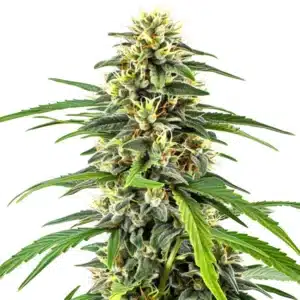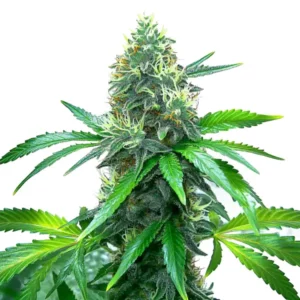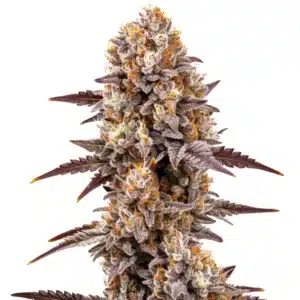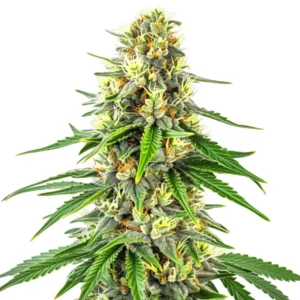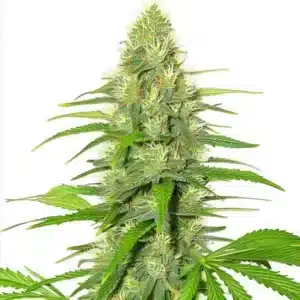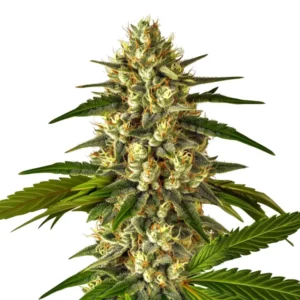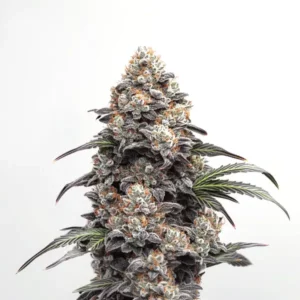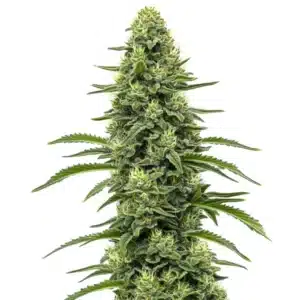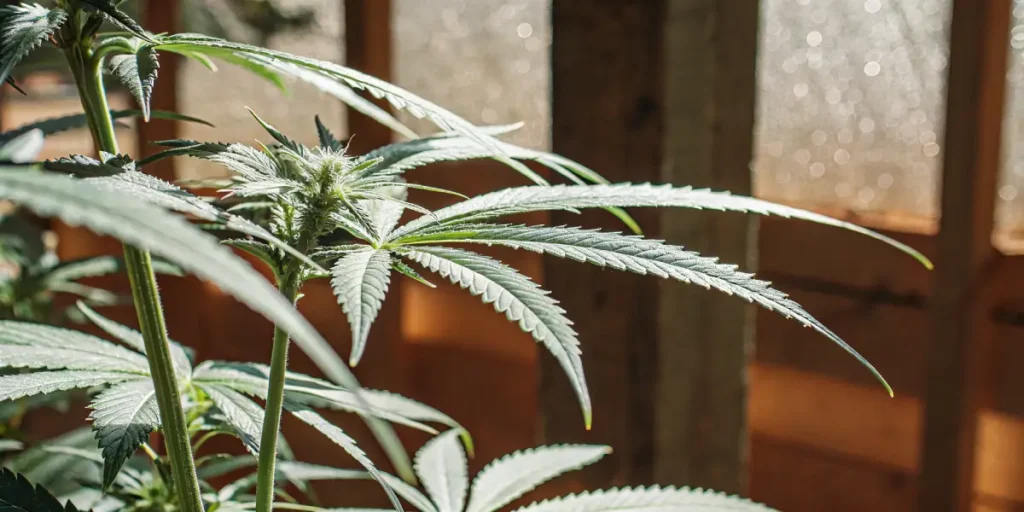
Transpiration and Nutrient Flow in Cannabis: Explained
Transpiration and nutrient flow in cannabis are essential for healthy plant development. Transpiration is the process where water evaporates from the leaves, creating a pull that draws water and nutrients up through the plant. This process not only cools the plant but also facilitates nutrient transport from the roots to the leaves.
When cannabis plants transpire, they release water vapor into the atmosphere through small openings on the leaves called stomata. This is crucial for the plant’s cooling system and nutrient flow. The evaporative cooling effect prevents the plant from overheating, while the water movement helps transport essential nutrients.
Recommended Strains
Amnesia Haze
|
|
THC | 18% - 22% (Medium) |
|
|
Type | Feminized |
|
|
Yield | High |
|
|
Phenotype | 30% Indica / 70% Sativa |
OG Kush
|
|
THC | 20% - 24% (Medium) |
|
|
Type | Feminized |
|
|
Yield | Medium |
|
|
Phenotype | 55% Indica / 45% Sativa |
Cannabis water uptake and nutrient transport are closely linked. As water moves up through the plant, it carries dissolved nutrients essential for growth. Transpiration creates a negative pressure that aids in this nutrient transport, ensuring that all parts of the plant receive the nourishment they need.
How Transpiration Affects Nutrient Flow in Cannabis
Transpiration affects nutrient flow in cannabis by regulating the movement of water and nutrients from the roots to the leaves. This process is vital for nutrient distribution. Without adequate transpiration, nutrient uptake would be inefficient, leading to deficiencies and poor plant health.
The relationship between transpiration and nutrient distribution in cannabis is symbiotic. As water exits the leaves, it pulls nutrients up from the roots. This constant movement ensures that the plant’s cells are well-nourished, supporting growth and development.
Knowing cannabis transpiration and nutrient pathways involves recognizing the complex interactions between environmental factors and plant physiology. These pathways are crucial for maintaining the plant’s internal balance and ensuring optimal growth conditions. By knowing these processes, growers can better manage their crops.
Transpiration and nutrient flow in cannabis: explained, is not just about the movement of water and nutrients but also about maintaining the overall health of the plant. A thorough knowing of these processes allows growers to make informed decisions, enhancing the efficiency and productivity of their cultivation efforts.
Practical Implications for Growers
Growers must monitor environmental conditions to optimize transpiration and nutrient flow. Factors like humidity, temperature, and airflow play significant roles in this process. Maintaining a balanced environment promotes healthy transpiration rates.
For instance, high humidity levels can slow down transpiration, leading to nutrient deficiencies. Conversely, low humidity can lead to excessive transpiration, causing nutrient burn. Thus, finding the right balance is crucial for optimal cannabis growth.
Effective management of the cannabis nutrient flow and transpiration process requires a keen eye on environmental changes. Growers should adjust conditions as needed to prevent stress on the plants. This proactive approach ensures that plants remain healthy and productive throughout their growth cycle.
Incorporating technology, such as automated environmental control systems, can greatly aid in maintaining the ideal conditions for cannabis water uptake and nutrient transport. These systems provide real-time data and adjustments, allowing growers to focus on other aspects of cultivation while ensuring optimal plant health.
Promos & Deals
Knowing Cannabis Transpiration and Nutrient Pathways
Cannabis nutrient flow and the transpiration process are interconnected. Water absorbed by the roots travels through the plant’s vascular system, carrying nutrients to various parts. This nutrient pathway is essential for photosynthesis and overall plant health.
Efficient nutrient flow requires a healthy root system and open stomata. Roots take in water and nutrients, while open stomata facilitate transpiration and gas exchange. This balance is vital for healthy plant growth.
The complex network of roots, stems, and leaves forms the basis for knowing cannabis transpiration and nutrient pathways. These pathways are analogous to a well-designed irrigation system, ensuring that every part of the plant receives adequate hydration and nutrients.
By fully grasping how transpiration affects nutrient flow in cannabis, growers can tailor their practices to support these natural processes. This includes selecting appropriate soil types, optimizing watering schedules, and choosing nutrient formulations that complement the plant’s physiological needs.

Real-Life Examples of Managing Transpiration
Managing transpiration in real-world settings involves monitoring and adjusting environmental factors. Growers often use tools like hygrometers and thermometers to maintain optimal conditions. Proper ventilation systems also help regulate airflow and humidity.
Strains such as Amnesia Haze from Blimburn Seeds are excellent for growers seeking robust plants with high nutrient uptake efficiency. These strains can withstand varied environmental conditions, making them a great choice for both novice and experienced growers.
Real-life applications of managing transpiration include using shading techniques during extreme heat to prevent excessive water loss. This not only protects the plant but also ensures that the cannabis water uptake and nutrient transport remain efficient.
Another practical example is the use of mulch to retain soil moisture and support consistent nutrient flow. This helps maintain a stable environment for root development, which is crucial for the overall health and yield of the cannabis plants.
Optimizing Cannabis Water Uptake and Nutrient Transport
Optimizing cannabis water uptake and nutrient transport involves knowing and adjusting environmental variables. Light exposure, temperature, and humidity levels all influence these processes. Properly balanced conditions lead to healthier plants.
Growers can utilize strains like OG Kush from Blimburn Seeds, known for their high resilience to environmental stressors. Such strains are ideal for those looking to maximize water and nutrient efficiency in their cannabis crops.
The key to optimizing these processes lies in the ability to fine-tune the growing environment. This includes precise control over light cycles and spectrum, which can significantly impact transpiration rates and nutrient flow in cannabis.
Regular soil testing and analysis can also aid in optimizing cannabis water uptake and nutrient transport. By knowing the specific needs of their plants, growers can adjust fertilizer applications to support the natural transpiration and nutrient pathways effectively.
Tips for Enhancing Nutrient Flow
Enhancing nutrient flow starts with ensuring an optimal growing environment. Adjusting light schedules and using reflective materials can maximize photosynthesis, thereby improving transpiration rates. This adjustment aids in better nutrient distribution.
Regularly inspecting plants for signs of nutrient deficiencies or excesses is also crucial. Yellowing leaves or burnt tips can indicate issues with transpiration or nutrient flow. Addressing these signs early can prevent long-term damage to the plant.
Incorporating organic matter into the soil can enhance the root environment, promoting effective cannabis water uptake and nutrient transport. This practice not only improves soil structure but also provides a steady release of nutrients that support plant development.
Pruning techniques can also enhance nutrient flow by removing excess foliage that may hinder light penetration and air circulation. This ensures that the entire plant benefits from the available resources, leading to more robust growth and yield.

FAQs
What is the relationship between transpiration and nutrient distribution in cannabis?
Transpiration and nutrient distribution are closely linked in cannabis. As the plant transpires, water is drawn from the roots to the leaves, carrying essential nutrients along the way. This movement is crucial for distributing nutrients throughout the plant.
Without effective transpiration, nutrient flow would be disrupted, leading to deficiencies. Therefore, maintaining optimal conditions for transpiration is vital for healthy cannabis growth and development.
The relationship between transpiration and nutrient distribution in cannabis highlights the importance of a holistic approach to plant care. By focusing on both water management and nutrient availability, growers can create an environment that supports the entire growth cycle.
Advanced irrigation systems, such as drip irrigation, can further enhance this relationship by providing precise water delivery, supporting consistent nutrient uptake and efficient transpiration rates.
How does humidity affect the cannabis nutrient flow and transpiration process?
Humidity levels significantly impact the cannabis nutrient flow and transpiration process. High humidity can reduce transpiration rates, slowing nutrient uptake and potentially leading to deficiencies. Low humidity, on the other hand, can increase transpiration, risking nutrient burn.
Growers need to find a balance, typically maintaining humidity between 40-60% during the vegetative stage and slightly lower during flowering. This balance supports efficient transpiration and nutrient distribution.
Knowing cannabis transpiration and nutrient pathways requires careful monitoring of humidity to ensure that the plant’s physiological processes are not hindered. This knowing is crucial for maintaining consistent growth and maximizing yield potential.
Implementing environmental control systems, such as dehumidifiers or humidifiers, can help maintain the ideal humidity levels, ensuring the cannabis nutrient flow and transpiration process remains efficient throughout the growing season.
Why is transpiration important for cannabis growth?
Transpiration is important for cannabis growth because it regulates temperature and facilitates nutrient transport. The process helps cool the plant and ensures nutrients reach all parts of the plant, supporting photosynthesis and growth.
Without effective transpiration, plants may overheat and suffer from nutrient deficiencies, affecting overall health and yield. Thus, optimizing transpiration is crucial for successful cannabis cultivation.
Transpiration and nutrient flow in cannabis: explained, is essential knowledge for any grower aiming to maximize their plant’s potential. By ensuring effective transpiration, growers can support robust plant development and achieve higher quality yields.
Transpiration also plays a critical role in maintaining plant turgor pressure, which is vital for structural support and resistance to environmental stressors. Knowing this process allows growers to create conditions that promote resilience and vigor.
What role do stomata play in transpiration and nutrient flow in cannabis?
Stomata are small openings on the leaves that play a key role in transpiration and nutrient flow in cannabis. They regulate gas exchange and water vapor release, which is essential for transpiration.
Open stomata allow for effective water movement through the plant, facilitating nutrient transport from roots to leaves. Proper management of light and humidity helps maintain optimal stomatal function.
The function of stomata is intricately linked to the cannabis water uptake and nutrient transport processes. By knowing how these tiny structures operate, growers can better manage their crops and optimize nutrient flow.
Ensuring that stomata remain functional and responsive to environmental cues is a key aspect of maintaining healthy transpiration rates. This involves balancing light exposure and humidity to keep the stomata operating efficiently.
How can I improve cannabis water uptake and nutrient transport?
Improving cannabis water uptake and nutrient transport involves optimizing environmental conditions. Factors like light, temperature, and humidity should be carefully controlled to promote healthy transpiration and nutrient flow.
Using appropriate strains, such as those from Blimburn Seeds, and employing proper watering and fertilization techniques can also enhance these processes. Regular monitoring and adjustments ensure the plants receive optimal care.
Advanced cultivation techniques, such as hydroponics or aeroponics, can significantly improve cannabis water uptake and nutrient transport by providing a controlled environment that maximizes resource efficiency.
Regularly updating and calibrating irrigation systems ensures that plants receive consistent water and nutrient delivery, supporting efficient transpiration and nutrient flow. This approach is fundamental for achieving high-quality cannabis crops.


